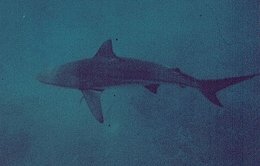
The sand shark belongs to the faimly (Odontaspididae) sand tigers), they have several tropical to cool temperate coastal species, one of which has been occasionally caught in the East Cape region of New Zealand.
Sometimes this shark is known as the grey nurse shark.
The sand shark lives in shallow waters usually around 18mts or 60ft, around reefs, and coastlines, often near the sea floor. Many come right in to tide line along the beaches.
This sluggish shark rarely attacks people but can be dangerous to swimmers. It is generally nocturnal (most active at night).
The sand shark has similarities to the mako,and the bronze whaler, but they differ by the fact of having a large second dorsal fin.
The sand shark grows to around 3.2mts or 10.5ft long
The sand shark has a flattened snout, conical with rather sharp tip, and a stocky body.
Their two dorsal fins are without spines and are pretty much the same size. The rear end of the base of the first dorsal is over or in front of pelvic fins.
The the anal fin is about as large as the dorsals, the upper lobe of the caudal fin is much longer than the lower. The sharks fifth gill openings are farther forward than the origins of the pectoral fins.
The upper lobe of the tail is nearly a third as long as the head and body together, and it is notched near its tip, with the lower lobe about one-third as long as the upper lobe.
Sand sharks are a browny grey colour above, slightly darker along it's back, snout and the upper sides of pectorals. They are grayish white on lower sides of the main body, rearward from pectorals has roundish to oval spots.
A characteristic of this shark is that it can swallow air in its stomach and hold it there, enabling the shark to remain motionless in the water (this gives the shark neutral buoyancy, simulating the swim bladder of bony fish).
Their teeth are long, narrow, sharp pointed, and smooth-edged.
It catches fish using the long, sharp, teeth in the front of its mouth (each of these teeth has one large point in the middle and a smaller point on each side). The teeth in the back of the mouth are smaller.
Their main diet consists of a great number of small fish such as flounder, butterfish, mackerel, flounder, and sometimes crayfish, crabs, and squid.
After a gestation period of 9 to 12 months the eggs of the sand shark are hatched within the parent.
The sand shark has many eggs that hatch in the two uterus, unfortunately the largest strongest shark in each uterus eats the others, so only one pup survives in each uterus. Thus the parent gives birth to only two live young in each litter.
The young newly born pups are roughly 1mt or 3ft long and weigh about 6kg or 13lbs.